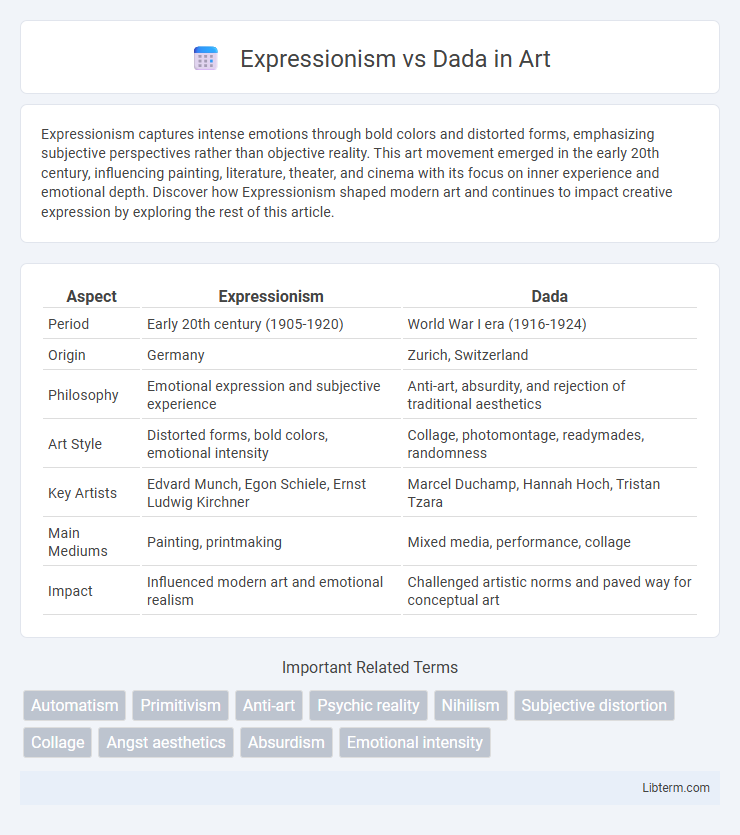Expressionism captures intense emotions through bold colors and distorted forms, emphasizing subjective perspectives rather than objective reality. This art movement emerged in the early 20th century, influencing painting, literature, theater, and cinema with its focus on inner experience and emotional depth. Discover how Expressionism shaped modern art and continues to impact creative expression by exploring the rest of this article.
Table of Comparison
| Aspect | Expressionism | Dada |
|---|---|---|
| Period | Early 20th century (1905-1920) | World War I era (1916-1924) |
| Origin | Germany | Zurich, Switzerland |
| Philosophy | Emotional expression and subjective experience | Anti-art, absurdity, and rejection of traditional aesthetics |
| Art Style | Distorted forms, bold colors, emotional intensity | Collage, photomontage, readymades, randomness |
| Key Artists | Edvard Munch, Egon Schiele, Ernst Ludwig Kirchner | Marcel Duchamp, Hannah Hoch, Tristan Tzara |
| Main Mediums | Painting, printmaking | Mixed media, performance, collage |
| Impact | Influenced modern art and emotional realism | Challenged artistic norms and paved way for conceptual art |
Introduction to Expressionism and Dada
Expressionism emerged in early 20th-century Germany, emphasizing intense emotional experience through distorted forms, vivid colors, and bold brushstrokes to reflect inner turmoil and social critique. Dada originated during World War I as an anti-art movement in Zurich, rejecting traditional aesthetics and logic by embracing absurdity, randomness, and satire to challenge cultural and political norms. Both movements radically transformed modern art by prioritizing subjective experience and subverting conventional artistic values.
Historical Context of Both Movements
Expressionism emerged in early 20th-century Germany as a reaction to rapid industrialization and the anxieties of World War I, emphasizing emotional experience and individual perspective through distorted forms and vivid colors. Dada arose during World War I in Zurich as an anti-war, anti-art movement, rejecting traditional aesthetics and rationality by embracing chaos, absurdity, and irrationality in response to the horrors and disillusionment caused by the conflict. Both movements reflect the turbulent socio-political climate of early 20th-century Europe but diverge in their artistic intentions and responses to societal upheaval.
Core Philosophies: Emotion vs Absurdity
Expressionism centers on conveying intense emotional experiences and subjective perspectives, emphasizing inner turmoil and personal reflection through distorted, vivid imagery. Dada rejects traditional aesthetic values by embracing absurdity, chaos, and irrationality as a response to the horrors of World War I, challenging logic and reason. The core philosophical divergence lies in Expressionism's pursuit of emotional truth versus Dada's celebration of nonsense and anti-art rebellion.
Influential Artists in Expressionism
Expressionism, characterized by intense emotional expression and vivid colors, was significantly shaped by artists such as Edvard Munch, Egon Schiele, and Ernst Ludwig Kirchner, who explored psychological depth through distorted forms. These influential figures emphasized subjective experience, contrasting with Dada's embrace of absurdity and anti-art sentiments, led by figures like Marcel Duchamp and Tristan Tzara. The emotional intensity and individual perspective in Expressionism established a foundation for modernist movements by challenging traditional aesthetics and exploring human angst.
Pioneering Figures in Dada
Pioneering figures in Dada such as Tristan Tzara, Marcel Duchamp, and Hannah Hoch challenged traditional artistic norms by embracing chaos and anti-establishment themes, contrasting sharply with Expressionism's focus on emotional intensity and individual perspective. Tristan Tzara's manifestos and performances rejected rationality, while Marcel Duchamp's readymades redefined art's boundaries, and Hannah Hoch's photomontages critiqued societal conventions. These innovators positioned Dada as a radical movement that subverted expressionist ideals through absurdity and political critique.
Distinctive Artistic Techniques
Expressionism employs bold colors, exaggerated forms, and emotive brushstrokes to convey intense psychological states and subjective experiences. Dada utilizes collage, photomontage, and assemblage techniques, often incorporating found objects and nonsensical elements to challenge traditional aesthetics and provoke anti-art sentiments. While Expressionism emphasizes emotional depth, Dada prioritizes absurdity and spontaneous creation to undermine cultural conventions.
Impact on Literature and Performance
Expressionism revolutionized literature and performance by emphasizing emotional experience and subjective reality through distorted characters and settings, profoundly influencing theatrical techniques such as exaggerated gestures and nonlinear narratives. Dada challenged traditional art forms by embracing absurdity, satire, and anti-establishment themes, leading to experimental literature that deconstructed language and narrative structure, while pioneering performance art that blurred boundaries between audience and performer. Both movements reshaped modern literature and theater, with Expressionism intensifying psychological depth and Dada promoting radical innovation and cultural critique.
Political and Social Influences
Expressionism emerged as a response to the anxieties of early 20th-century society, highlighting emotional experience and individual perspective to critique war, industrialization, and social alienation. Dada rejected traditional art and culture outright, using absurdity and anti-bourgeois protest as a means to challenge the nationalism and rationalism that contributed to World War I. Both movements politicized art by confronting societal injustices and upheavals, with Expressionism reflecting emotional turmoil and Dada embodying radical dissent against established political and social orders.
Lasting Legacy in Modern Art
Expressionism's lasting legacy in modern art lies in its intense emotional impact and bold use of color and form, influencing contemporary movements like Abstract Expressionism and Neo-Expressionism. Dada's enduring impact is seen in its radical challenge to traditional art norms, inspiring conceptual art, performance art, and the use of absurdity and irony in contemporary practices. Both movements reshaped artistic boundaries, promoting innovation and critical reflection in modern creative expression.
Expressionism vs Dada: Key Differences and Similarities
Expressionism emphasizes emotional experience and subjective interpretation through distorted forms and vivid colors, aiming to evoke intense feelings. Dada, emerging as an anti-art movement, challenges traditional aesthetics by embracing absurdity, randomness, and irony to critique societal norms and war. Both movements reject academic art conventions, yet Expressionism seeks to convey inner emotional truths, whereas Dada focuses on dismantling cultural values through provocative and often nonsensical works.
Expressionism Infographic

 libterm.com
libterm.com